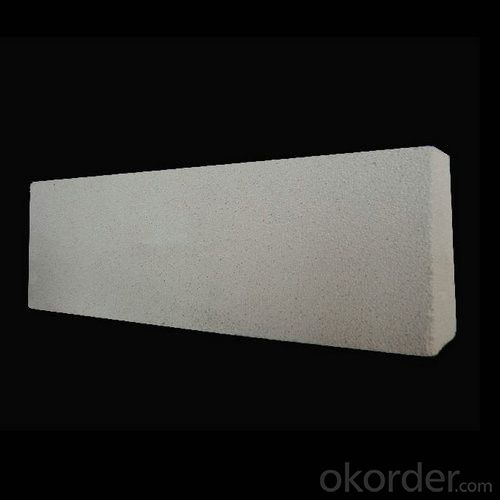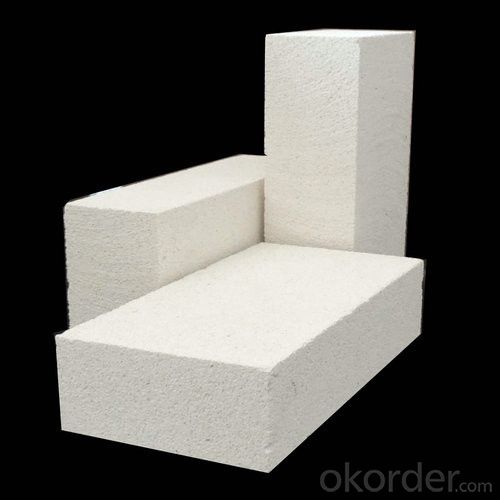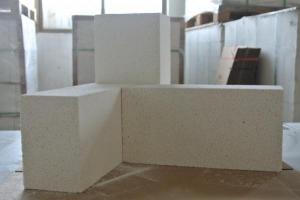Insulating Fire Brick - Chamotte Refractory Insulated Fire Bricks for Fireplace
- Loading Port:
- Shanghai
- Payment Terms:
- TT or LC
- Min Order Qty:
- 1 m.t.
- Supply Capability:
- 1000 m.t./month
OKorder Service Pledge
OKorder Financial Service
You Might Also Like
General Information of Insulated Fire Brick
CMAX Insulated Fire Brick are classified under temperature between 1300℃ to 1700℃, manufactured from high purity alumina clay.
Feature of Insulated Fire Brick
Light weight and low thermal conductivity
Low heat storage
Low iron and impurities
High thermal shock resistance
Application of Insulated Fire Brick
CMAX Insulated Fire Brick can be used as a hot face lining directly exposed to the heat or as a backup insulation layer in iron and steel mills, non-ferrous foundries, petrochemical, ceramic, glass.
Image of Insulated Fire Brick



Technical Data of Insulated Firebricks

Why Choose Us
l We are a government owned company with ISO certificate.
l We are listed in Global Fortune 500 with D & B report.
l We have more than 11 refractory production facilities and bases across China. We have a wide products range, such as ceramic fiber products (ceramic fiber blanket, module, board, paper, bulk), ceramic fiber textile (ceramic fiber rope, cloth, tape, yarn) etc, refractory brick (fireclay brick, high alumina brick, silica brick, magnesia brick etc), monolithic refractory materials, insulating fire brick, calcium silicate board, mica sheet, steel fiber. You can find various products here, and we can combine the light weight ceramic fiber products with the heavy weight refractory brick in one container delivery, then save the sea freight for you.
l We have strict materials selecting system and quality control system. We have the ability to take responsibility for your orders and product quality.
FAQ
Q1: How do you control the products quality?
A1: With strict quality control system throughout the materials selection and production process, our refractory and ceramic fiber products quality is effectively controlled to meet customer requirements.
From the raw materials selecting, our quality control begin. The quality certificates of raw materials are required and each batch will be tested before using. During production, the quality control are conducted by workers and then each piece will be sorted and examined by quality supervis
Q2: What`s the lead time for my order?
A2: It depends on customers’ requirements and our production schedule. And usually we need 30-60 days for refractory bricks,10-25 days for unshaped refractory materials and 10-20 days for ceramic fiber blankets.
Q3: Can you offer Door-to-Door delivery?
A3: Yes, but only for some countries such us U.S., UAE, Saudi Arabia, Iran, and Russia, etc.
Q4: What is the minimum quantity?
A4: There is no minimum order quantity. Depending on the item and processing, there may be a minimum production required, however we can offer a quotation based only on the quantity you need.
Q5: Can you give me a brief introduction of the application of your products?
A5: CNBM (China National Building Material) core refractory business comprises the production, sale and installation of high-grade refractory products, the development and implementation of customized system solutions as well as rendering outstanding services for the key industries in Glass, Iron& Steel, Petrochemical, Cement, Ceramic and Nonferrous Metals.
- Q: Do insulating fire bricks have a high fireproof rating?
- Insulating fire bricks indeed have a high fireproof rating. These bricks are specifically designed to withstand extremely high temperatures and provide excellent insulation against heat transfer. They are made from special refractory materials that have low thermal conductivity, which helps in retaining heat and preventing it from escaping the system. Insulating fire bricks can withstand temperatures ranging from 2300°F to 3100°F (1260°C to 1700°C), making them ideal for use in furnaces, kilns, fireplaces, and other high-temperature applications. Their high fireproof rating ensures that they can effectively protect structures and equipment from the intense heat and flames, allowing for safe and efficient operation in various industries.
- Q: Are insulating fire bricks suitable for use in incinerators?
- Yes, insulating fire bricks are suitable for use in incinerators. Insulating fire bricks are specifically designed to withstand high temperatures and provide excellent insulation properties, making them ideal for use in incinerators. They have a high resistance to thermal shock and can retain their structural integrity even when exposed to extreme heat conditions. Additionally, insulating fire bricks have low thermal conductivity, which helps in reducing heat loss and improving the overall energy efficiency of the incinerator. Their ability to withstand high temperatures and provide effective insulation makes them a reliable choice for use in incinerators.
- Q: Can insulating fire bricks be used for insulation in cement kilns?
- Yes, insulating fire bricks can be used for insulation in cement kilns. Insulating fire bricks have excellent thermal insulation properties and can withstand high temperatures, making them suitable for insulating cement kilns and reducing heat loss.
- Q: Can insulating fire bricks be used in chimneys and fireplaces?
- Chimneys and fireplaces can indeed utilize insulating fire bricks. These bricks are specifically crafted to endure high temperatures and offer exceptional insulation. They are constructed from lightweight materials like ceramic fibers or refractory materials, which aid in minimizing heat transfer. Thus, they are an optimal choice for lining chimneys and fireplaces since they retain heat within the firebox and prevent its escape through the chimney. Moreover, insulating fire bricks enhance the heating system's efficiency by reducing heat loss and elevating the overall heat output. However, it is crucial to emphasize that insulating fire bricks should only be employed in appropriate sections of the chimney or fireplace, such as the firebox. Conversely, the smoke chamber or flue necessitate different types of bricks capable of withstanding the corrosive effects of flue gases.
- Q: Can insulating fire bricks be used in glass melting furnaces?
- Yes, insulating fire bricks can be used in glass melting furnaces. These bricks are designed to withstand high temperatures and provide excellent insulation, making them suitable for use in furnaces where glass is melted.
- Q: Can insulating fire bricks be used in biomass boilers?
- Yes, insulating fire bricks can be used in biomass boilers. These bricks are designed to withstand high temperatures and provide excellent insulation, making them suitable for use in biomass boilers where heat retention is crucial for efficient combustion.
- Q: What is the typical porosity of an insulating fire brick?
- The typical porosity of an insulating fire brick varies depending on the specific type and composition of the brick. However, in general, insulating fire bricks have a porosity range of 40% to 70%. The porosity refers to the amount of open space or voids within the brick structure. These voids allow for the brick to have better thermal insulation properties by reducing heat transfer. The higher the porosity, the better the insulation capability of the brick. Manufacturers of insulating fire bricks often aim for a specific porosity range based on the desired thermal conductivity and insulation efficiency.
- Q: Can insulating fire bricks be used in the construction of heat recovery systems?
- Yes, insulating fire bricks can be used in the construction of heat recovery systems. Insulating fire bricks are designed to withstand high temperatures and provide excellent thermal insulation, making them an ideal choice for heat recovery systems. These bricks are made from lightweight materials, such as ceramic fibers or refractory materials, which have low thermal conductivity. This property allows them to effectively trap and retain heat, preventing it from escaping the system and maximizing energy efficiency. Additionally, insulating fire bricks are resistant to thermal shock, meaning they can withstand rapid temperature changes without cracking or breaking. This makes them suitable for the varying heat conditions often found in heat recovery systems. Overall, using insulating fire bricks in the construction of heat recovery systems can help improve their performance and efficiency by minimizing heat loss and optimizing energy recovery.
- Q: Can insulating fire bricks be used in the construction of flue liners?
- Yes, insulating fire bricks can be used in the construction of flue liners. These bricks are designed to withstand high temperatures and provide excellent insulation. They help to retain the heat within the flue, improve the efficiency of the heating system, and reduce the risk of heat transfer to surrounding structures.
- Q: Do insulating fire bricks have a high resistance to creep?
- Yes, insulating fire bricks have a high resistance to creep. Creep refers to the tendency of a material to deform over time under a constant load or stress. Insulating fire bricks are designed to withstand high temperatures and maintain their shape and integrity even under prolonged exposure to heat. These bricks are made of lightweight refractory materials, such as clay, which have low thermal conductivity and excellent resistance to thermal shock. The combination of these properties allows insulating fire bricks to resist creep and maintain their structural stability even in demanding and extreme conditions.
Send your message to us
Insulating Fire Brick - Chamotte Refractory Insulated Fire Bricks for Fireplace
- Loading Port:
- Shanghai
- Payment Terms:
- TT or LC
- Min Order Qty:
- 1 m.t.
- Supply Capability:
- 1000 m.t./month
OKorder Service Pledge
OKorder Financial Service
Similar products
Hot products
Hot Searches
Related keywords































